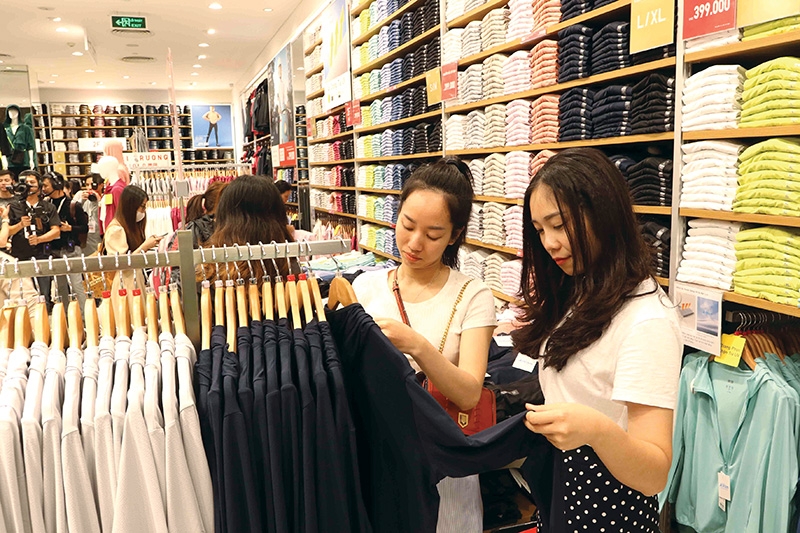 |
|
Vietnam’s rapid development across the board is something foreign fashion brands can tap into
|
According to industry insiders, Vietnam’s fashion industry will enjoy the fastest growth rate in Asia, presenting more opportunities than Japan. In light of this, apparel retailers are eyeing Vietnam as a key consumption hub in Southeast Asia.
Japanese brand UNIQLO officially launched its flagship store, UNIQLO Dong Khoi, in Ho Chi Minh City last month and will open the second store in Hanoi this spring.
Tadashi Yanai, founder and chairman as well as president of Fast Retailing Group, has been bullish about the company’s prospects in Vietnam. “I think Vietnam has massive potential and will be one of the biggest consumer markets in the world,” he said prior to the Ho Chi Minh City branch opening.
Fast Retailing is a global company that operates multiple fashion brands including UNIQLO, GU, and Theory. The group has to explore new markets in the likes of Vietnam, Italy, and India as Japan’s ageing population slows down the prospects of rapid growth in the sector.
An ongoing trade dispute between Japan and South Korea, as well as other regional factors, means firms like UNIQLO may pay even more attention to the opportunities available in Vietnam and other similar markets in the coming time.
Vietnam is also an important country in Asia for such groups in the digital age. While UNIQLO can implement some unique business strategies in Vietnam, which it could not carry out in other markets, it can also expect to contribute to the country’s rapid growth. The company and its partners are producing an annual output of $3 billion for export markets in Vietnam, and the retailer hopes to increase both output and local consumption here.
In addition to UNIQLO, other Japanese apparel manufacturers have ramped up operations in Vietnam. Matsuoka Corporation plans to build a new factory to reduce its reliance on the Chinese market. Its subsidiary, Annam Matsuoka May Garment Company, will develop the factory in the central province of Nghe An.
Meanwhile, Japanese trading house Itochu currently exports over ¥60 billion worth of garments from Vietnam, equivalent to $547.5 million a year.
Itochu aims to increase outsourcing and exports to ¥100 billion ($912.5 million) by 2021. The company currently holds ties with more than 100 Vietnamese textile and apparel businesses.
The trends have been on the rise for several years. Stripe International, a Japanese apparel manufacturing mainstay, acquired NEM Group’s apparel brand in 2017. The NEM fashion brand has since doubled the number of its stores to 90 as well as scaled up its presence nationwide. After the deal, Stripe International continued its buying spree by taking over Vietnamese women’s footwear brand Vascara in September. The move reflects Stripe International’s ambition to foray deeper into the Vietnamese fashion industry.
Last February, Japanese investment fund Advantage Partners also wrapped up its acquisition of Vietnamese fashion brand Elise. In the next five years, Elise will continue to focus on the women’s fashion segment, which is predicted to reach $2 billion in 2022 with an annual growth rate of about 30 per cent.
With fresh capital from Japanese investment, Elise is set to double its outlets and quadruple its revenue. As of present, the brand has 95 stores nationwide with three factories and 30 exclusive outsourcing companies, supplying 3 million products per year.
Ralf Matthaes, managing director of Infocus Mekong, said that as Southeast Asia’s third-most populous country, with an average age of 30 and the fastest-growing middle class in the region, fast fashion is taking a hold in Vietnam. Along with Japan, Europe and North America’s populations are ageing too, while the Vietnamese youth are now more likely to express their individuality through fashion, making the country a key potential market for these brands.
“Besides reasonable price, fashion brands need to understand the cross-over of the functionality of fabrics for Vietnam’s hot climate, while providing the latest fashion styles, cuts, and colours,” said Matthaes. “Gone are the days of conformity and fitting in. Many Vietnamese now want to stand out from the crowd, look elegant, successful, sexy, and fashionable, while not emptying their bank accounts to do so.”
He pointed out some indicators of opportunity including population, age, and GDP growth, as well as lifestyle, youth trends, and overall cultural trends.
The continuing emergence of Japanese fashion brands will intensify the competition in a market where international brands like Zara and H&M and home-grown brands such as Canifa, Hnoss, and IVY Moda are actively expanding their presence.
In this context, many Vietnamese brands have been struggling to keep their market share, such as Ninomaxx, N&M, Blue Exchange, and PT 2000. Hnoss, meanwhile, even sold out its business to Vietnamese retail-management company Seedcom in 2018 due to fierce competition. Several mid-range fashion brands are facing many difficulties in terms of premium, sales channels, operation, and management, and these factors mean opportunities for big foreign brands from the likes of Japan this year and beyond. VIR
Thanh Van
 Japanese fashion brands are swooping into Vietnam as local consumers become more brand-sensitive as they grow prosperous." itemprop="description" />
Japanese fashion brands are swooping into Vietnam as local consumers become more brand-sensitive as they grow prosperous." itemprop="description" />